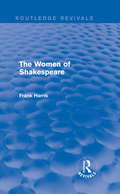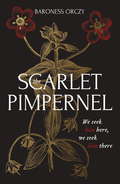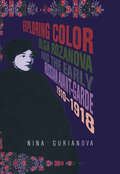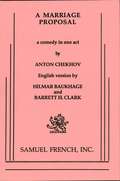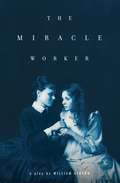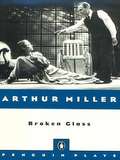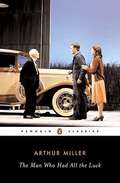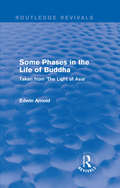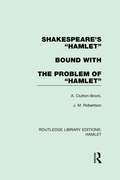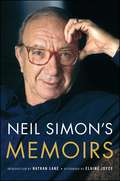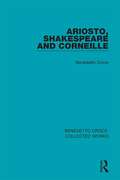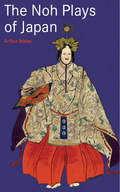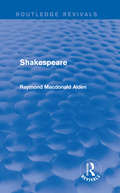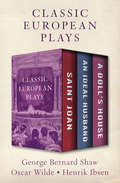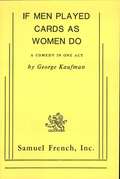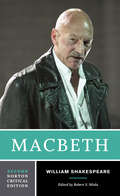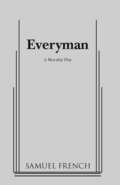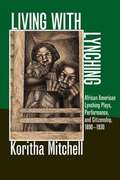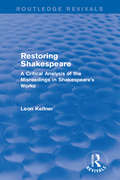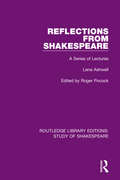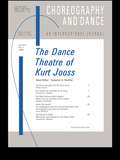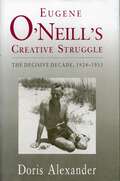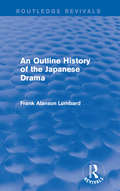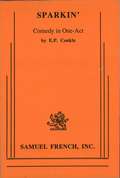- Table View
- List View
The Women of Shakespeare (Routledge Revivals)
by Frank HarrisFrank Harris argues that the way women are presented in Shakespeare’s plays and sonnets are a reflection of the real-life women in his life, namely his wife, mother, mistress and daughter. Originally published in 1911, The Women of Shakespeare also analyses the traditional criticism of the time and places his own views in this context. This title will be of interest to students of English Literature.
The Scarlet Pimpernel: Large Print (The Psammead Ser. #Vol. 1)
by Baroness OrczyBaroness Orczy's classic tale of adventure during the French Revolution. Also available as an unabridged audiobook, read by Julian Rhind-Tutt.Paris, 1792. The Terror has begun. Every day, scores of the French nobility are delivered to the guillotine. Trapped in the capital, they have no way of escape. But rumours abound of a league of young English gentlemen who are risking their lives to spirit French aristocrats away to safety across the Channel. Led by a man known only as the 'Scarlet Pimpernel', they leave no trace behind them save a single note. Determined to stop them, ruthless spymaster Chauvelin travels to England and embarks on a quest to uncover the identity of their leader, forcing the Scarlet Pimpernel and his men to summon all their courage and wits to evade capture and stay alive.PRAISE FOR THE SCARLET PIMPERNEL"Anyone who feels that their outward manner is but a travesty of their inner self can hardly fail to respond to THE SCARLET PIMPERNEL" - Independent"The Baroness Orczy invented the "masked avenger" genre of fiction - the swashbuckling hero of dual identity. Her progeny include Zorro, Superman, The Lone Ranger and many others." - Audiofile Magazine
Exploring Color: Olga Rozanova and the Early Russian Avant-Garde 1910-1918
by Nina GurianovaThis is an examination of the paintings, books, poetry and theoretical work of Russian avant-garde artist, Olga Rozanova. The text assesses Rozanova's life and work, aiming to recreate the spirit of the counterculture milieu that contributed to the transformation of 20th-century art.
Marriage Proposal (Clark)
by Anton ChekhovShort plays, farce / 2m, 1 f / Interior / Mod. or Russian cost. This little farce is very popular and one of the funniest ever written. The story tells of the efforts of a nervous and excitable man who starts to propose to an attractive young woman, but who gets into a tremendous quarrel over a boundary line.
The Miracle Worker: A Play
by William GibsonNO ONE COULD REACH HER Twelve-year-old Helen Keller lived in a prison of silence and darkness. Born deaf, blind, and mute, with no way to express herself or comprehend those around her, she flew into primal rages against anyone who tried to help her, fighting tooth and nail with a strength born of furious, unknowing desperation. Then Annie Sullivan came. Half-blind herself, but possessing an almost fanatical determination, she would begin a frightening and incredibly moving struggle to tame the wild girl no one could reach, and bring Helen into the world at last....
Broken Glass
by Arthur MillerTHE STORY: Brooklyn, New York. The end of November, 1938. Sylvia Gellberg has suddenly, mysteriously, become paralyzed from the waist down. As the play opens, her husband, Phillip, and her doctor, Dr. Hyman, meet to discuss the prognosis and test results. The doctor assures Phillip that physically, there is nothing wrong with his wife and that she is sane, but advises the only way to discover the cause of her paralysis is to probe into her psyche. At this point, the author begins to peel away all the layers of the characters' lives in this stunning, deeply effective exploration of what it means to be American and Jewish in 1938. In his attempts to uncover the truth about Sylvia's paralysis, Dr. Hyman, via conversations with Phillip, Sylvia, and her sister, Harriet, discovers that the Gellberg's marriage was built on resentment and that over the years has become loveless. While Sylvia's affliction leaves her terrified, it exposes Phillip's deepest emotions. He hates himself, and he loathes being Jewish. His self-hatred has always made him cold, and at times even cruel, yet, Sylvia's condition has magnified his feelings leaving him out of control with her, with Dr. Hyman and even with his employers. Dr. Hyman's obsessive determination to cure Sylvia leads him to discover that her paralysis occurred quickly after a newspaper report on Krystallnacht and an accompanying photograph of two old men forced to clean the streets of Germany with toothbrushes. She feels something must be done to stop the Nazis while most Americans believe the Germans won't allow them to get out of hand. But what can she do when she can't even change her own life? The atrocities in Germany, her husband's denial of his Jewishness and her own realization that she threw her life away have overcome her. Suddenly, she no longer simply feels helpless, she has truly become helpless. Finally, with everyone's feelings laid bare, the play comes to its heart-wrenching, electrifying conclusion, as Phillip has a heart attack and begs Sylvia's forgiveness as he dies.
The Man Who Had All the Luck
by Arthur MillerThe forgotten classic that launched the career of one of America's greatest playwrights It took more than fifty years for The Man Who Had All the Luck to be appreciated for what it truly is: the first stirrings of a genius that would go on to blossom in such masterpieces as Death of a Salesman and The Crucible. Infused with the moral malaise of the Depression era, the parable-like drama centers on David Beeves, a man whose every obstacle to personal and professional success seems to crumble before him with ease. But his good fortune merely serves to reveal the tragedies of those around him in greater relief, offering what David believes to be evidence of a capricious god or, worse, a godless, arbitrary universe. David’s journey toward fulfillment becomes a nightmare of existential doubts, a desperate grasp for reason in a cosmos seemingly devoid of any, and a struggle that will take him to the brink of madness. This Penguin Classics edition includes an introduction by Christopher Bigsby. .
Routledge Revivals: Taken from 'The Light of Asia' (Routledge Revivals)
by Edwin ArnoldFirst published in 1915, this book presents a dramatization of part ofthe author's The Light of Asia. The original text represents one of the first successful attempts to popularise Buddhism and its founder Gautama Buddha — presenting his life, teachings and philosophy in verse poetry. This adaptation dramatizes part of the The Light of Asia and includes staging instructions, properties required, illustrative drawings of suggested costumes, and incidental music composed specifically for the piece. This book will be of interest to students of Indian and Buddhist literature — and how this has interacted with the West — as well as students of drama.
Shakespeare's Hamlet bound with The Problem of Hamlet (Routledge Library Editions: Hamlet)
by A. Clutton-Brock J. M. RobertsonThis volume combines two classic works on Hamlet, first published in 1919 and 1922. The first book's original description says that it contains a theory which attempts to explain an everlasting problem - it insists that Hamlet is neither a failure not an accident, but a very great work of art. In a final chapter, the play is examined as an aesthetic document. It is a profoundly interesting and not unprovocative work. The second book reviews and attempts to resolve the most interesting debate of any Shakespeare play and presents proper method for investigating the genesis of the plays in this way.
Neil Simon's Memoirs
by Neil SimonThe complete memoirs of playwright Neil Simon--the author of such iconic works as Lost in Yonkers, The Odd Couple, Biloxi Blues, and The Goodbye Girl--now with a new introduction and afterword.This omnibus edition combines Neil Simon's two memoirs, Rewrites and The Play Goes On, into one volume that spans his extraordinary five-decade career in theater, television, and film. Rewrites takes Simon through his first love, his first play, and his first brush with failure. There is the humor of growing up in Washington Heights (the inspiration for his play Brighton Beach Memoirs) where, despite his parents' rocky marriage and many separations, he learned to see the funny side of family drama, as when his mother screamed thinking she saw a body on the floor in their apartment--it turned out to be the clothes his father discarded in the hallway after a night of carousing. He describes his marriage to his beloved wife Joan, and writes lucidly about the pain of losing her to cancer. The Play Goes On adds to his life's story, as he wins the Pulitzer Prize and reflects with humor and insight on his tumultuous life and meteoric career. Now, with the whole story in one place, Neil Simon's collected memoirs trace the history of modern entertainment over the last fifty years through the eyes of a man who started life the son of a garment salesman and became the greatest--and most successful--American playwright of all time.
Ariosto, Shakespeare and Corneille (Collected Works)
by Benedetto CroceOriginally published in 1921 this volume consists of the first of Croce’s literary criticisms to be published in English and as well as a section on Shakespeare, it contains unique essays on Ariosto and Corneille which together inaugurated a new era in literary criticism. The essays are based on Croce’s Theory of Aesthetic - a theory which to many is the only one that completely explains the problem of poetry and the fine arts - and as a result are profound and suggestive.
The Noh Plays of Japan
by Arthur WaleyFirst published in 1921, The Noh Plays of Japan has been justly famous for more than three-quarters of a century and established the Noh play for the Western reader as beautiful literature. It contains translations of nineteen plays and summaries of sixteen more.
The Noh Plays of Japan
by Arthur WaleyFirst published in 1921, The Noh Plays of Japan has been justly famous for more than three-quarters of a century and established the Noh play for the Western reader as beautiful literature. It contains translations of nineteen plays and summaries of sixteen more.
Shakespeare: From The Quarto Of 1609, With Variorum Readings And Commentary (Routledge Revivals)
by Raymond Macdonald AldenThis fascinating title, first published in 1922, presents a detailed overview of the life and works of Shakespeare. Alden first considers Shakespeare’s Elizabethan context, alongside exploring the Classical and Italian foundations, political theories, concepts and theatrical trends that influenced his works. Next, a comprehensive biography provides insight into Shakespeare’s probable education, relationships and contemporaries. The final sections are devoted to the genres into which Shakespeare’s works have been categorised, with full analyses of and backgrounds to the poems, histories, comedies and tragedies. An important study, this title will be of particular value to students in need of a comprehensive overview of Shakespeare’s life and works, as well as the more general inquisitive reader.
Classic European Plays: Saint Joan, An Ideal Husband, and A Doll's House
by George Bernard Shaw Oscar Wilde Henrik IbsenThese three timeless plays showcase the sparkling wit and provocative intellect of some of modern drama&’s greatest playwrights.Saint Joan by George Bernard Shaw: This complex drama depicts the life of Joan of Arc—from her childhood vision calling her to lead the French army against the English in the Hundred Years War through her eventual capture, trial, and burning at the stake. An epilogue depicts a retrial that clears Joan of heresy, declaring her a Christian martyr.An Ideal Husband by Oscar Wilde: In this timeless drawing room comedy, a blackmail scheme forces a married couple to reexamine their moral standards—providing a wry commentary on the hypocrisy of politicians. Carried along by nonstop witty repartee, this is satirical theater at its finest.A Doll&’s House by Henrik Ibsen: This quintessential work of dramatic realism depicts one woman&’s struggle against patriarchal society. The central character&’s rejection of a smothering marriage shocked theatergoers of the late nineteenth century while the play&’s pioneering style set the stage for twentieth century domestic drama.
If Men Played Cards As Women Do
by George S. KaufmanComedy / 4m / Interior / A brilliant satire for men, successfully played in Irving Berlin's "Music Box Revue." The fun is derived from the fact that a group of men at the bridge table speak, behave, and think after the manner in which women are supposed to conduct their game. A good tournament play.
Macbeth (Second Edition) (Norton Critical Editions)
by William Shakespeare Robert S. MiolaA tragedy that evokes both pity and terror—now in a thoroughly revised and updated Norton Critical Edition. The Norton Critical Edition is again based on the First Folio (1623), the only authoritative text of the play. The volume includes a revised introduction and new annotations and textual notes. The Second Edition also includes the innovative feature “The Actors’ Gallery,” which presents famous actors and actresses—among them David Garrick, Sarah Siddons, Ian McKellen, Hira Mikijirô, Patrick Stewart, and Kate Fleetwood—reflecting on their roles in major productions of Macbeth for stage and screen. “Sources and Contexts” provides readers with an understanding of Macbeth’s origins in earlier texts, specifically the works of the Roman playwright Seneca, the Tudor historian Raphael Holinshed, and the medieval drama The Slaughter of the Innocents and the Death of Herod. Contexts for the play include contemporary debates on predestination versus free will (Martin Luther versus Erasmus), witchcraft as fiction or fact (Reginald Scott versus King James I), the ethics of regicide (an Elizabethan homily versus Jan de Mariana, S.J.), and the ethics of equivocation (Henry Garnet, S.J., versus—new to the Second Edition—Sir Edward Coke). Eight carefully chosen essays represent four hundred years of critical and theatrical interpretation. Contributors include Simon Forman, Samuel Johnson, Samuel Taylor Coleridge, Thomas De Quincey, Harry Levin, Stephen Orgel, Peter Holland, and, presenting the latest arguments on the authorship controversy, Gary Taylor. Finally, an engaging new selection of Macbeth’s “Afterlives” includes excerpts from Giuseppi Verdi’s Macbeth and related letters, Eugene Ionesco’s Macbett (1972), Bill Cain’s Equivocation (2009), and more. This edition also provides a list of online and print resources.
Everyman
by AnonymousThe old English morality play, without intermission. Anonymous. 11 m., 6 f., but these may be taken by all male or female cast. The most beautiful of all the old English religious plays. Especially recommended to churches and schools.
Living with Lynching: African American Lynching Plays, Performance, and Citizenship, 1890-1930
by Koritha MitchellLiving with Lynching: African American Lynching Plays, Performance, and Citizenship, 1890-1930 demonstrates that popular lynching plays were mechanisms through which African American communities survived actual and photographic mob violence. Often available in periodicals, lynching plays were read aloud or acted out by black church members, schoolchildren, and families. Koritha Mitchell shows that African Americans performed and read the scripts in community settings to certify to each other that lynch victims were not the isolated brutes that dominant discourses made them out to be. Instead, the play scripts often described victims as honorable heads of household being torn from model domestic units by white violence. In closely analyzing the political and spiritual uses of black theatre during the Progressive Era, Mitchell demonstrates that audiences were shown affective ties in black families, a subject often erased in mainstream images of African Americans. Examining lynching plays as archival texts that embody and reflect broad networks of sociocultural activism and exchange in the lives of black Americans, Mitchell finds that audiences were rehearsing and improvising new ways of enduring in the face of widespread racial terrorism. Images of the black soldier, lawyer, mother, and wife helped readers assure each other that they were upstanding individuals who deserved the right to participate in national culture and politics. These powerful community coping efforts helped African Americans band together and withstand the nation's rejection of them as viable citizens.
Restoring Shakespeare: A Critical Analysis of the Misreadings in Shakespeare's Works (Routledge Revivals)
by Leon KellnerThe genius of Shakespeare is not always accessible or easily understandable to readers and audiences. Leon Kellner points out that sometimes Shakespeare’s languages does not make sense at all but this is not necessarily because his metaphors are too complex. Rather, the printing of his works is often filled with errors. Originally published in 1925, Kellner’s work explores the reasons and potential mistakes which may account for the unintelligible passages in Shakespeare such as handwriting, abbreviations, and the confusing of pronouns. This title will be of interest to students of English Literature and Linguistics.
Reflections From Shakespeare: A Series of Lectures (Routledge Library Editions: Study of Shakespeare)
by Lena AshwellOriginally published in 1926, this title was edited from a series of lectures the author gave to raise money for her theatre group the Lena Ashwell Players. Through her work as a producer the author gained a deeper knowledge of a number of Shakespeare’s plays and in order to support her work gave a number of lectures on "Women in Shakespeare". This title was perhaps the first book by a woman of the profession, appealing to the public for a larger and deeper understanding of Shakespeare: the man, his life, and that group of tragedies in which he fathomed Hell, then scaled the Heavens.
The Dance Theatre of Kurt Jooss
by Suzanne WaltherFirst Published in 1997. Routledge is an imprint of Taylor & Francis, an informa company.
Eugene O'Neill's Creative Struggle: The Decisive Decade, 1924–1933
by Doris AlexanderIn Eugene O'Neill's Creative Struggle, Doris Alexander gives us a new kind of inside biography that begins where the others leave off. It follows O'Neill through the door into his writing room to give a blow-by-blow account of how he fought out in his plays his great life battles—love against hate, doubt against belief, life against death—to an ever-expanding understanding. It presents a new kind of criticism, showing how O'Neill's most intimate struggles worked their way to resolution through the drama of his plays. Alexander reveals that he was engineering his own consciousness through his plays and solving his life problems—while the tone, imagery, and richness of the plays all came out of the nexus of memories summoned up by the urgency of the problems he faced in them. By the way of O'Neill, this study moves toward a theory of the impulse that sets off a writer's creativity, and a theory of how that impulse acts to shape a work, not only in a dramatist like O'Neill but also in the case of writers in other mediums, and even of painters and composers. The study begins with Desire Under the Elms because that play's plot was consolidated by a dream that opened up the transfixing grief that precipitated the play for O'Neill, and it ends with Days Without End when he had resolved his major emotional-philosophical struggle and created within himself the voice of his final great plays. Since the analysis brings to bear on the plays all of his conscious decisions, ideas, theories, as well as the life-and-death struggles motivating them, documenting even the final creative changes made during rehearsals, this book provides a definitive account of the nine plays analyzed in detail (Desire Under the Elms, Marco Millions, The Great God Brown, Lazarus Laughed, Strange Interlude, Dynamo, Mourning Becomes Electra, Ah, Wilderness!, and Days Without End, with additional analysis of plays written before and after.
An Outline History of the Japanese Drama (Routledge Revivals)
by Frank Alanson LombardStudents of international drama are turning more and more to the study of Japanese drama, desirous to know to what extent its development duplicates or differs from the evolution of drama in other countries. Stimulated by the colour, originality, power, and poetry, they are interested to know more. This title, first published in 1928, traces the general development of the drama of the Japanese. This book will be of interest to students of drama, theatre studies and Asian Studies.
Sparkin'
by E. P. ConkleComedy / 1m, 3f / This is a delightful little comedy of small town Nebraska people and has to do with a timid young man who goes courting, but is unable to come to the point until Granny teaches him how to become a man.
